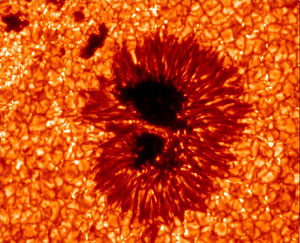 A typical, Earth-sized sunspot as seen by Hinode.
A typical, Earth-sized sunspot as seen by Hinode.
Credit: Hinode, National Astronomical Observtory of Japan (NAOJ)A new day has dawned-- so to speak...
Last September, the Japanese space agency, JAXA, launched a new solar observatory satellite, originally designated as "Solar-B." Upon its successful launch, the spacecraft was bestowed its nickname, Hinode (pronounced “heh NO day”), which means sunrise--a name selected through a student contest in Japan.
Though Hinode isn’t the first space borne solar observatory, it’s a significant step up in capability for this type of tool for understanding our Sun, and by extension other stars. If you want to see the kind of stunning imagery delivered to us by predecessor spacecraft, check out some of these websites: the European SOHO spacecraft, NASA’s TRACE spacecraft, and NASA’s newest, STEREO.
What’s the connection to the Bay Area, you might ask? Hinode, though a Japanese science mission, is an international collaboration between Japan, the UK, and the US through NASA. The package of scientific instruments created for the main Hinode telescope was designed and built by the Lockheed Martin Solar and Astrophysics Lab in Palo Alto (also the lab that built TRACE, and some of the instrumentation for SOHO). Also, Chabot Space & Science Center conducts an educational and public outreach program for this mission-- check out our own website .
The floodgates of Hinode’s stunning imagery will be opened some time in May, following the initial multi-month “commissioning phase” of the spacecraft, during which project scientists and engineers have activated and tested all of Hinode’s science and operational systems. You can see some “sneak peeks” at the NASA website.
